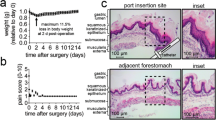Abstract
Helicobacter pylori infection has been linked tothe development of gastritis which can then progress toa number of disease entities including peptic ulcerdisease and gastric cancer. Since the pathogenic mechanism by which the bacteria causesgastritis is unresolved, we employed a model system, theH. felis-infected mouse to investigate the temporalrelationship between bacterially-induced alterations in the hydrophobic phospholipid barrier of thestomach and the development of gastritis. In the presentstudy, C57BL/6 mice were inoculated with 109CFU of H. felis and the changes in gastric wet weight, histology, surface hydrophobicity,phospholipid/phosphatidylcholine concentration,phospholipase A2 activity, and the pH ofcollected gastric juice were measured 0.5-2 monthspostinoculation. In related experiments, we investigated the effects oftreating H. felis infected mice with antibiotic/bismuththerapy on the above gastric properties. It wasdetermined that both gastric surface hydrophobicity and phospholipid composition were significantlyattenuated as early as 2-4 weeks postinfection,preceding signs of mucosal inflammation and glandularatrophy as indicated by increases in gastric wet weight, pH and a disappearance in parietal cells. Theseearly H. felis-induced changes in gastric surfacehydrophobicity and phospholipid concentration werereversed by antibiotic/bismuth therapy. Based on these results we conclude that H. felis infectioninduces an early transformation of the stomach from ahydrophobic to an acid-sensitive hydrophilic state thatmay trigger the subsequent development ofgastritis.
Similar content being viewed by others
REFERENCES
Moss SJ: Helicobacter pylori and peptic ulcers: the current position. Gut 33:289-292, 1992
Lambert JR, Lin SK: Prevalence/dise ase correlates of H. pylori.In Helicobacter pylori: Basic Mechanisms to Clinical Cure. RH Hunt, GNJ Tytgat (eds). Dordrecht, Kluwer Academic Publishers, 1994, pp 95-112
Parsonnet J, Friedman GD, Vandersteen DP, Chang Y, Vogelman JH, Orentreich N, Sibley RK: Helicobacter pylori infection and the risk of gastric carcinoma. N Engl J Med 325:1127-1131, 1991
IARC Working Group on the Evaluation of Carcinogenic Risks to Humans: Helicobacter pylori. In Schistosomes, Liver Flukes and Helicobacter pylori. 61 IARC Monographs on the Evaluation of Carcinogenic Risks to Humans. Lyon, International Agency for Research on Cancer, 1994
Marshall BJ, Warren JR: Unidentified curved bacilli in the stomachs of patients with gastritis and peptic ulceration. Lancet 1:1311-1315, 1984
Hills B, Butler BD, Lichtenberger LM: Gastric mucosal barrier: The hydrophobic lining to the lumen of the stomach. Am J Physiol 244:G561-G568, 1983
Lichtenberger LM: The hydrophobic barrier properties of gastrointestinal mucus. Annu Rev Physiol 57:565-583, 1995
Spychal RT, Goggin PM, Marrero JM, Saverymuttu SH, Yu CW, Corbishley CM, Maxwell JD, Nothfield, TC: Surface hydrophobicity of gastric mucosa in peptic ulcer disease. Gastroenterology 98:1250-1254, 1990
Goggin PM, Marrero JM, Spychal RI, Jackson PA, Corbishley CM, Northfield TC: Surface hydrophobicity of the gastric mucosa in Helicobacter pylori infection: effect of clearance and eradication. Gastroente rology 103:1486-1490, 1992
Nardone G, D'Armieto F, Corso G, Civiletti C, Coscione P: Lipids of human gastric mucosa: Effect of inflammatory infiltrates, Helicobacter pylori, infection and non-alcoholic cirrhosis.Gastroente rology 107:362-368, 1994
Asante M, Ahmed H, Patel P, Davis T, Finlayson C, Mendall M, Northfield TC: Gastric mucosal hydrophobicity in duodenal ulceration: Role of Helicobacter pylori infection density and mucus lipids. Gastroenterology 113:449-454, 1997
Slomiany BL, Kasinathan C, Slomiany A: Lipolytic activity of Campylobacter pylori: Effects of colloidal bismuth subcitrate (De-Nol). Am J Gastroenterol 84:1273-1277, 1989
Ottlecz A, Romero JJ, Hazell SL, Graham DY, Lichtenberger LM: Phospholipase activity of Helicobacter pylori and its inhibition by bismuth salts. Dig Dis Sci 38:2071-2080, 1993
Lee A, Fox JG, Murphy J: A small animal model of human Helicobacter pylori active gastritis. Gastroenterology 99:1315-1323, 1990
Fox JG, Li X, Cahill RJ, Andrutis K, Rustgi AK, Odze R, Wang TC: Hypertrophic gastropathy in Helicobacter felisinfected wild-type C57BL/6 mice and p53 hemizygous transgenic mice. Gastroente rology 110:155-166, 1996
Hazell SL, Borody TJ, Gall A, Lee A: Campylobacte r pyloridis gastritis. Am J Gastroenterol 82:292-296, 1987
Bligh EG, Dyer WJ: A rapid me thod of total lipid extraction and purification. Can J Biochem Physiol 37:911-917, 1959
Rouser G, Siratos AN, Fleisher S: Quantitative analysis of phospholipids by thin layer chromatography and phosphorus analysis of spots. Lipids 1:85-86, 1966
Skipski U, Peterson RF, Sanders J, Barclay M: Thin-layer chromatography of phospholipids using silica gel without calcium binder. J Lipid Res 4:227-228, 1963
Shakir KMM: Phospholipase A2 activity of post-heparin plasma: Rapid and sensitive assay and partial characterization. Anal Biochem 114:64-70, 1981
Mobley HL: Helicobacter pylori factors associated with disease development. Gastroenterology 113:S21-S28, 1997
Covacci A: Mobilis in mobile: Unexpected flexibility and quantum leaps in the Helicobacter pylori genome. In Helicobacter pylori: Basic Mechanisms to Clinical Cure 1996. RH Hunt, GNJ Tytgat (eds). Dordrecht, Kluwer Academic Publishers, 1996, pp 40-49
Ernst PB, Crowe SE, Reyes VE: How does Helicobacter pylori cause mucosal damage? The inflammatory response. Gastroenterology 113:S35-S42, 1997
Genta RM: Helicobacter pylori; inflammation, mucosal damage and apoptosis: pathogenesis and definition of gastric atrophy. Gastroenterology 113:S51-A55, 1997
Lichtenberger LM, Romero JJ: Effect of ammonium ion on the hydrophobic barrier properties of the gastric mucus gel layer: Implications on the role of ammonium in H. pylori-induced gastritis. J Gastroenterol Hepatol 9:S13-S19, 1994
Wang TC, Goldenring JR, Dangler C, Ito S, Mueller A, Jeon WK, Koh TJ, Fox JG: Mice lacking secretory phospholipase A2 show altered apoptosis and differentiation with Helicobacter felis Infection. Gastroenterology 114:675-689, 1998
Rights and permissions
About this article
Cite this article
Lichtenberger, L.M., Dial, E.J., Ottlecz, A. et al. Attenuation of Hydrophobic Phospholipid Barrier Is an Early Event in Helicobacter felis-Induced Gastritis in Mice. Dig Dis Sci 44, 108–115 (1999). https://doi.org/10.1023/A:1026610418663
Issue Date:
DOI: https://doi.org/10.1023/A:1026610418663




